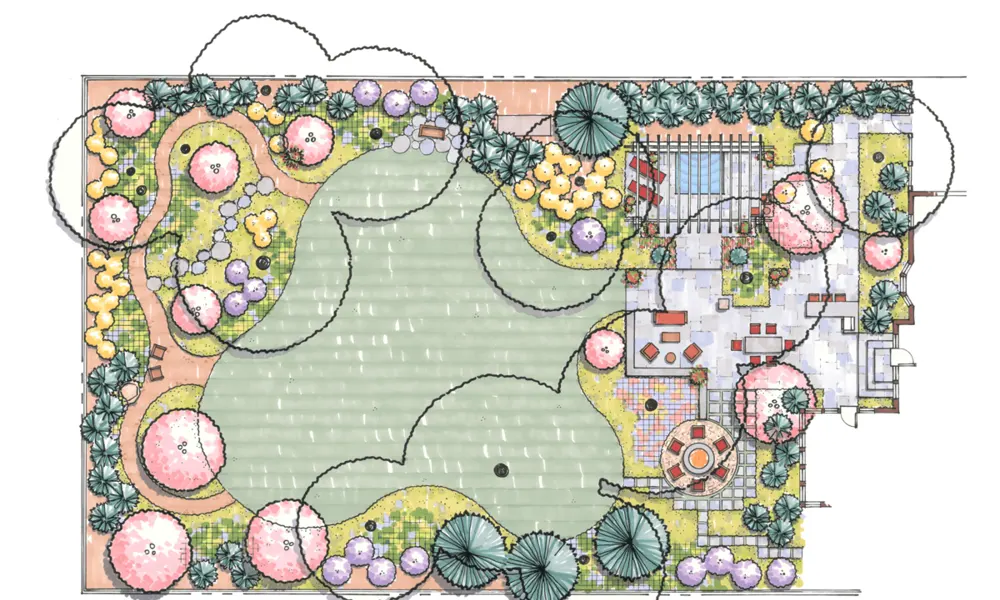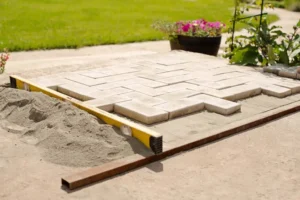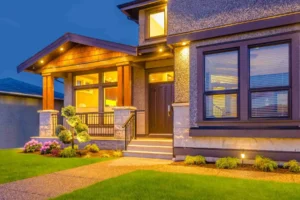How to design a landscape plan starts with understanding the blueprint that guides every successful outdoor project. A landscape plan is a detailed layout that shows the placement of plants, pathways, lighting, and other elements to bring a cohesive vision to life. Planning landscape design in advance helps avoid costly mistakes, ensures proper spacing, and aligns your yard with functional needs and aesthetic goals. Whether you’re starting with a simple landscape plan or a full-scale design, thoughtful planning saves time and maximizes results. In this guide, you’ll learn the five core principles of landscape design, explore different types of plans, and discover when it’s best to consult a professional.
How to Design a Landscape Plan in Five Easy Steps

Designing a landscape doesn’t have to be overwhelming. Whether you’re enhancing curb appeal or creating a relaxing outdoor space, following a structured approach helps ensure success. Here’s how to create simple landscape plans in five easy steps.
Step 1: Analyze Your Site
Start by assessing your yard’s natural features. Observe sun and shade patterns throughout the day, take note of any slopes or drainage issues, and test your soil type. This information is essential for choosing plants and hardscape features that will thrive in your environment. A thorough site analysis forms the foundation of any effective landscaping plan.
Step 2: Determine Your Needs and Wants
Think about how you’ll use the space. Do you need a play area for kids, a quiet spot for reading, or a garden for growing herbs? Identify functional zones that serve your lifestyle. This step helps prioritize features that matter most, whether it’s a fire pit, pergola, or vegetable beds. Knowing your needs early leads to more practical and tailored landscape design plans.
Step 3: Create a Rough Sketch or Base Map
Draw a basic layout of your yard to scale, marking existing structures, trees, and property lines. You can do this by hand or use digital landscape design tools. This simple landscape plan serves as your visual guide, helping you position elements logically and ensure balance in your layout.
Step 4: Choose Plants and Materials
Select plants suited to your local climate, soil, and sunlight conditions. Native and drought-tolerant varieties are excellent for low-maintenance, water-efficient landscaping. Also, decide on materials for walkways, patios, and edging. Matching your choices with your site analysis keeps your landscaping plan both beautiful and sustainable.
Step 5: Finalize and Refine the Plan
Review your layout to align with your budget, timeline, and irrigation needs. Make any necessary adjustments, like resizing garden beds or changing materials for cost efficiency. This final step ties all parts of your landscape design plans together, ensuring everything works cohesively before installation begins.
You may read about How Much Does Landscape Design Cost?
5 Basic Principles of Landscape Design
Creating a cohesive and visually appealing outdoor space begins with understanding the core principles behind every effective landscaping plan. These five basic principles help you develop simple landscape plans that are both functional and beautiful.
1. Unity
Unity means maintaining a consistent style across your yard. Whether you prefer a modern, minimalist look or a lush, cottage-style garden, every element should feel like it belongs. Repeating colors, materials, or plant types throughout your landscape design plans helps create a sense of wholeness and continuity.
2. Balance
Balance brings stability to your design. A symmetrical design places matching elements on either side of a central point ideal for formal spaces. In contrast, an asymmetrical approach uses different elements that carry equal visual weight for a more natural, informal look. Both options serve different landscaping plan goals depending on your personal aesthetic.
3. Contrast and Harmony
Using contrast and harmony helps guide the eye and enhance interest. Combine bold textures with soft foliage or bright flowers with neutral hardscapes to create visual impact. At the same time, ensure all elements work together so the space feels cohesive. These techniques can elevate even the most simple landscape plan.
4. Proportion
Proportion is about scale the size relationship between plants, structures, and open space. Large trees next to tiny shrubs can look awkward, while properly scaled features maintain balance and usability. Keeping proportion in mind ensures that every part of your landscape design plans fits naturally within the overall space.
5. Rhythm and Repetition
Repeating patterns, shapes, or colors leads the eye smoothly through the landscape. Whether it’s a row of planters or repeated lighting elements, rhythm gives your space a sense of movement and order. This design principle helps connect different zones within your landscaping plan and makes the layout feel intentional. If you want professional Landscape design service in San Jose then contact no other than Lakota Design Group.
Types of Landscapes: Choosing the Right Style for Your Property

When planning landscape design, selecting the right landscape style sets the tone for your entire outdoor space. From structured gardens to natural retreats, understanding the types of landscapes helps you create a landscaping plan that suits your lifestyle, climate, and property layout.
Formal vs. Informal Landscapes
Formal landscapes feature symmetry, straight lines, and well-organized plant arrangements. They often include neatly trimmed hedges, geometric pathways, and coordinated color schemes. In contrast, informal landscapes use curved lines, varied plant groupings, and a more relaxed, natural feel. Your choice depends on whether you prefer order and structure or a more casual, organic aesthetic when planning landscape design.
Xeriscape and Drought-Tolerant Designs
Xeriscaping focuses on water-efficient landscaping, using native and drought-tolerant plants, minimal turf, and efficient irrigation systems. This type of landscape is ideal for dry climates and helps reduce water use while still maintaining beauty. If you’re in a region with limited rainfall, xeriscape options should be central to your landscaping plan.
Modern, Tropical, Desert, Woodland, and More
Modern landscapes emphasize clean lines, minimalism, and architectural elements like concrete, gravel, and sculptural plants. Tropical landscapes use bold foliage, vibrant flowers, and water features for a lush, exotic look. Desert designs incorporate cacti, succulents, and rocks, while woodland landscapes blend native trees, ferns, and shade-loving plants for a natural forest feel. Each style offers different visual appeal and maintenance needs, so choose based on your environment and personal taste.
How to Choose the Right Landscape Type
Start by evaluating your climate, soil, and available sunlight. Then consider your lifestyle—do you need low-maintenance options, or do you enjoy gardening regularly? Also factor in how the space will be used: entertaining, relaxing, or playing. Aligning your landscape type with both your property’s characteristics and daily routine ensures your landscaping plan is practical, beautiful, and enduring. When planning landscape design, let functionality guide your aesthetic choices for long-term satisfaction.
When to Get Professional Help for Your Landscaping Plan
While some simple landscape plans can be managed on your own, others require the expertise and precision of a seasoned professional. Knowing when to get help can save you time, money, and unnecessary stress especially for more complex or large-scale projects. That’s where Lakota Design Group comes in.
Complex Grading or Drainage Issues
If your property has slopes, low spots, or water runoff problems, professional support is essential. Improper grading can cause serious drainage issues that damage your yard and home. At Lakota Design Group, we design solutions that integrate proper drainage into your landscaping plan, protecting your property for years to come.
Large-Scale or Commercial Projects
Bigger projects whether commercial or expansive residential properties—require careful planning, detailed logistics, and project oversight. From site assessments to design execution, Lakota Design Group brings structure and clarity to the entire process, making your landscaping plan manageable and stress-free.
High-End Design Vision Requiring Advanced Skills
When you’re envisioning custom outdoor features, modern landscape lighting, artificial turf, or luxury hardscapes, DIY won’t cut it. Our landscape design plans incorporate advanced techniques, premium materials, and precise installation all guided by your vision and needs.
Benefits of Hiring a Landscape Designer or Project Manager
Working with a professional saves you from costly errors, delays, and miscommunication. A skilled project manager oversees everything from design to installation, ensuring that each detail aligns with your timeline and budget. Lakota Design Group offers end-to-end support, making your planning landscape design process seamless and successful.
Ready to transform your outdoor space with confidence?
Contact Lakota Design Group today to schedule your consultation and get started on a landscaping plan designed for beauty, function, and long-term value.
FAQs
What Is The First Step In Designing A Landscape Plan?
The first step is analyzing your site. This includes evaluating sun and shade patterns, soil type, slope, and existing features. A proper site analysis lays the foundation for a functional and visually pleasing landscaping plan.
Can I Design A Simple Landscape Plan On My Own?
Yes, homeowners can create simple landscape plans using basic tools or digital design apps. Start with a base map, define your zones, and choose climate-appropriate plants. For complex projects, professional guidance is recommended.
What Should A Good Landscaping Plan Include?
A complete landscape plan should include a site analysis, functional zones, plant selection, hardscape elements, irrigation layout, and a maintenance plan. It helps ensure all features work together in harmony.
How Do I Choose The Right Plants For My Landscape Design?
Choose plants based on your region’s climate, sunlight exposure, soil conditions, and water availability. Native and drought-tolerant species are often ideal for sustainable and low-maintenance landscape design plans.
What Tools Can I Use To Create My Landscape Design Plan?
You can sketch your plan by hand or use landscape design software such as SketchUp, iScape, or SmartDraw. These tools help visualize space, scale, and layout more accurately.





